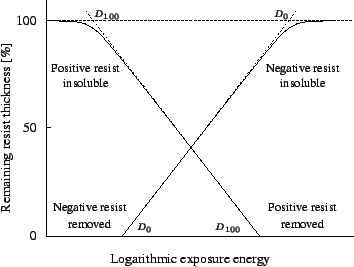



Next: 2.6.2 Composition of DQN
Up: 2.6 Photoresist
Previous: 2.6 Photoresist
The performance of any photoresist can be characterized by its
contrast curve. The contrast curve describes the remaining
resist fraction of a uniformly illuminated resist versus the logarithm
of the applied exposure dose. Idealized contrast curves for positive and
negative resists are shown in Figure 2.7.
The contrast  is given by the expression [23, p. 187]
is given by the expression [23, p. 187]
 |
(2.6) |
with doses D100 and D0 defined in Figure 2.7.
It is a simple measure of how well the resist can convert the
distorted patterns of a ``blurred'' aerial image into a ``sharp'' binary
stencil. Clearly, a high-contrast resist increases the resolution of the
entire lithography process by reducing the parameter k1
in (2.1).
Typical values for  range from 2-3. Hence,
D100 is 101/3 to 101/2 times lager than D0,
e.g., D0
range from 2-3. Hence,
D100 is 101/3 to 101/2 times lager than D0,
e.g., D0 50 mJ/cm2 and
D100
50 mJ/cm2 and
D100 150 mJ/cm2.
As the exposure
dose depends on the exposure intensity as well as on the exposure time
both quantities have to be chosen accordingly to transfer the
pattern into the resist. The contrast crucially depends on all of
the resist processing steps described in Section 2.6.3.
The absorption spectrum and the bleaching behavior are also
of great influence. Furthermore, second order effects like surface
reflection and a non-uniform resist thickness have to be taken into account.
150 mJ/cm2.
As the exposure
dose depends on the exposure intensity as well as on the exposure time
both quantities have to be chosen accordingly to transfer the
pattern into the resist. The contrast crucially depends on all of
the resist processing steps described in Section 2.6.3.
The absorption spectrum and the bleaching behavior are also
of great influence. Furthermore, second order effects like surface
reflection and a non-uniform resist thickness have to be taken into account.
Figure 2.7:
The
contrast curve is a
logarithmic sensitivity plot showing resist thickness versus exposure
energy. The contrast  is defined as the linear slope of the
transition region and describes the ability of the resist to
distinguish between light and dark areas.
is defined as the linear slope of the
transition region and describes the ability of the resist to
distinguish between light and dark areas.
|
|
In the following list some important resist properties are
summarized [24, p. 204]:
- Photospeed is determined by the quantum efficiency of the resist,
i.e., the ratio between the number of photoevents in the resist and
the incident photon flux density.
- Viscosity affects the flow characteristics and
film thickness, and depends on the solid content and temperature.
- Adhesion describes how strongly the film sticks to a broad
range of substrate materials like silicon, oxide, nitride, polysilicon,
and metals. Incomplete adhesion can cause a severe distortion or
even the loss of a pattern.
- Thermal stability is necessary to withstand resist processing
temperatures near
200 oC as well as additional
plasma and UV treatment after the development.
- Etch resistance determines the ability of the film to
protect the substrate from subsequent etching steps.
- Contamination of the resist by particulate and metal content
increases the pinhole density.
- Shelf-life refers to the storage time of the resist before
unacceptable changes of its properties occur.
- Pinhole density expresses the number of holes per unit area
created in the resist due to contaminants or inherent properties.
In a thinner resist the pinhole density increases.
- Charging becomes important during plasma etching or
deposition processes and ion implantation steps. The conductivity
of the resist plays an important role for the charging rate.
- Ease of processing generally describes the complexity
and difficulties to apply, develop, and strip the resist.




Next: 2.6.2 Composition of DQN
Up: 2.6 Photoresist
Previous: 2.6 Photoresist
Heinrich Kirchauer, Institute for Microelectronics, TU Vienna
1998-04-17


